Somewhere down the line... いつの頃からか...
Formerly, we had been able to find micro shells on sandy beaches everywhere.
To our regret, it has gotten difficult for us to find them, because of the engineering
works for bay protection and shore protection, resort development, and ocean pollution.
For the first year, the Nima Sand Museum had the experience corner where visitors
were able to pick up a shell in the sand of Kotoga beach, since it opened March 3th, 1991.
However, the number of UCHIAGE-GAI remarkably fell since the next year,
so we couldn't collect the sand containing micro shells, in the end we closed the corner without how to do.
微小貝は、昔はどこの砂浜でもよく見られたのですが、湾岸工事や護岸工事、リゾート開発
そして海洋汚染などのために、なかなか見つけることがむずしくなってしまいました。
仁摩サンドミュージアムでもオープンいらい一年ほど、琴ケ浜に打ち上げられた微小貝を
お客さんに拾いあげてもらうコーナーがありました。
ところが、二年目から浜辺にうちあげられる貝がめっきり少なくなり、拾ってもらうための貝の
まざった砂 (貝砂) もなくなり、やむなくコーナー は閉鎖されました。

"May it has been caused by the change of a climate or an ocean current?"
Yearly, I hoped the shells were washed up on the beach, but in the second and the third Spring tide ,
we weren't able to find the micro-shells performing the gorgeous fashion show on the beach.
Mr.Okamoto looks back in the magazine " Shell of Kyushu ",
Tsuyazaki was the richest place for a kind of drifting seashells in Fukuoka Prefecture in 1940's.
Many micro shells drift ashore on the beach 1km from the central part in the city.
The shells which was collected in the beach were more than 400 species.
"Long time ago, shells had lived here." Shell of Kyushu No19,20 union issue (1983)
Then, he listed name of seashells for the magazine that was many there in 1940's.
but UCHIAGE-GAI even got a few as not to speak of micro shells. I gather globigerinas, too,
but globigerinas decrease remarkably, too.
I think this is the one evidence that the fearful death of Nature is progressing fast in the invisible world.
I would be very happy that the shells Data base be useful to you.
 気候のせいか、海流が変わったのだろうか?と考えながら揚がってくるのを待っていましたが、
二年目も、そして三年目の春にも、微小貝の華やかな打ち上げを見ることはできませんでした。
故岡本 正豊さんによると、岡本さんの故郷の福岡県筑前あたりには、昔(35年以上前)鳴き砂 の浜が存在し、
微小貝も沢山いたそうですが、いまでは微小貝はおろか打ち上げ貝まで、少なくなったそうです。
有孔虫も微小貝といっしょに集めていますが、こちらも大変少なくなっています。
これは目には見えない小さな世界で、恐ろしい自然の死が進んでいるひとつの「あかし」ではないでしょうか?
気候のせいか、海流が変わったのだろうか?と考えながら揚がってくるのを待っていましたが、
二年目も、そして三年目の春にも、微小貝の華やかな打ち上げを見ることはできませんでした。
故岡本 正豊さんによると、岡本さんの故郷の福岡県筑前あたりには、昔(35年以上前)鳴き砂 の浜が存在し、
微小貝も沢山いたそうですが、いまでは微小貝はおろか打ち上げ貝まで、少なくなったそうです。
有孔虫も微小貝といっしょに集めていますが、こちらも大変少なくなっています。
これは目には見えない小さな世界で、恐ろしい自然の死が進んでいるひとつの「あかし」ではないでしょうか?
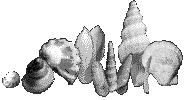
Small voice of shells 貝たちの小さな声
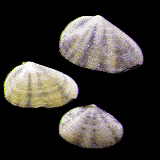 |
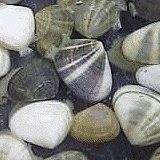 |
(写真左が島根県琴ケ浜産、右が与那原個体群)
I previously received an important message from Professor Masashi Yamaguchi of the Department of Marine and Natural Science, Faculty of Science, at the University of the Ryukyus.
On the main island of Okinawa, there are two species of wedge clams: the Naminokogai (Donax cuneatus) and the Ryukyu-naminoko. The Naminokogai forms populations where fine sand accumulates, so its habitats are limited.
They mainly inhabit five locations on the eastern side of Okinawa's main island. From north to south, there is one population each in Taira Bay and Oura Bay, and two populations in Kin Bay.
And the southernmost population, at Yonabaru Beach, is slightly different from those on other beaches; their shells have a more rounded shape. While this species originally shows great variation in shell patterns between individuals, this Yonabaru population has a different distribution ratio of color patterns, suggesting it is an independent and isolated group.
That Yonabaru Beach was slated to be completely landfilled (it has now been entirely filled in).
I wish to advance my research in population genetics, but I wonder if it is their fate to perish before the preparations can be made.
以前、琉球大学理学部 海洋自然科学科の山口 正士 先生 からたいせつなおはなしを頂きました。
沖縄本島にはナミノコガイとリュウキュウナミノコの2種類がいます。ナミノコガイは細かい砂の積もったところに集団をつくるるので、
場所が限られています。
おもに住んでいるところは、沖縄本島の東側で、5箇所あり、北から:平良湾と大浦湾に各1、金武湾に2箇所のナミノコガイが生息しています。
そしてもっとも南の与那原海岸(よなばるかいがん)sのナミノコガイは、ほかの浜のものとはすこし違って、貝がらの形 がより 丸み をおびています。
もともと貝の模様が、それぞれの貝によって違いが大きい種類ですが、 このヨナバル個体群は色彩型の配分比がことなっていて、
ほかの群とは独立した存在のようです。
その与那原海岸が、全面的にうめたてられることになりました(2025年現在、ほとんど埋めたれられました)。
集団遺伝学的な研究を進めたいのですが、それが準備できる前に死んでしまう運命でしょうか。
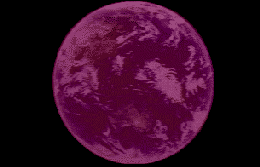 Small living things disappear gradually and quietly from the world for selfish animal -- mankind.
And the only living things survive having the ability to adapt, and continue the evolution.
As it was like that in Earth history so far, it may be 'Law of Nature'...
Small living things disappear gradually and quietly from the world for selfish animal -- mankind.
And the only living things survive having the ability to adapt, and continue the evolution.
As it was like that in Earth history so far, it may be 'Law of Nature'...
わがままな人間たちのために、小さな生きものから人知れず姿を消してゆきます。
そして環境に適応できる生物だけが生き残り、進化してゆく --- いままでの地球の歴史がそうだったのだから、それが「自然の摂理 」というものなのかも知れません。
そして 消えて行く者たちは、いつも寡黙です。
 But if they can speak, they might tell like this to you,
But if they can speak, they might tell like this to you,
" It's your turn next. "
でも、もし彼らが話せるとしたら、こう言うかもしれません。
「 わたしたちの次は、あなたたちの番ですよ 」
Dr. Tadashige Habe, who is president of MALACOLOGICAL SOCIETY of JAPAN, writes about Endangered Shells titled "Venus (Vol.53)", issued by MALACOLOGICAL SOCIETY of JAPAN. He wrote the following message in this magazine.
Mollusks and Environment -- Endangered Mollusks --
It is well known that many living things are threatened with extinction because over-development has been accelerating the destruction of nature and the pollution of the environment in recent five decades. "Japanese Red Data Book" to a list of the living things was printed and published by the Environment Agency in Japan, The following list is the report of non-marine molluscs in this book.
Endangered species -- 34 species
Vulnerable species -- 39 species
Rare species -- 55 places
Local population 2 species and 4 places
We are considering a research on marine molluscs; this is the state of affairs in Japan, because of domestic and industrial wastewater inflow and disappearance of the subtidal area by shore protection works, Tegillarca granosa(an edible bivalve) and many other species are threatened with extinction . Now or never, we should take measures for the protection of them, or we will have eternal regrets...
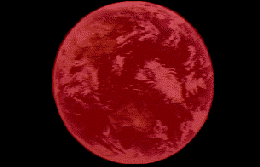 日本貝類学会誌 Venus Vol.53 に載った、故 波部 忠重 元日本貝類学会会長のメッセージ です。みなさんにもぜひ知っておいていただきたいので、一部ですがアップ します。
貝類と環境 -- 絶滅に瀕している貝類 --
日本貝類学会誌 Venus Vol.53 に載った、故 波部 忠重 元日本貝類学会会長のメッセージ です。みなさんにもぜひ知っておいていただきたいので、一部ですがアップ します。
貝類と環境 -- 絶滅に瀕している貝類 --
最近50年間の急激な開発によって、自然環境が破壊され、 多くの生物が絶滅の危機にさらされつつあることは、すでによく知られるところである。 それらの生物の目録 Red Data Book によると、 陸淡水貝類の絶滅危惧種 34、危急種 39、希少種 55、 特に保護すべき個体群2種4ケ所ある。
海産貝類についても検討中であるが、生活廃水や工業廃水、護岸工事による 潮間帯の消滅で、最近まで食用の貝として養殖されていた ハイガイ ( フネガイ科 : Tegillarca granosa ) などのおおくの種が絶滅に瀕しつつある現状である。 いまこそ、この現状を理解して保護対策をつくらなければ、悔いを万年にのこすことになる。---
Fantasy Micro shells Park 夢の微小貝遊園地
まだ汚染の少ない、日本海がわの島根県琴ケ浜、京都府丹後半島の琴引浜で沢山とれたので、
「電脳図鑑」として みなさんの参考にしていただけたらとおもいます。
 Compared to those early days, pollution from industrial sources within Japan may have decreased. However, this problem has often just been
shifted to other countries. Looking at the planet as a whole, our environment continues to worsen, from ocean pollution by plastic waste to the
loss of our sandy beaches due to global warming.
Compared to those early days, pollution from industrial sources within Japan may have decreased. However, this problem has often just been
shifted to other countries. Looking at the planet as a whole, our environment continues to worsen, from ocean pollution by plastic waste to the
loss of our sandy beaches due to global warming.
And still, perhaps we must continue to raise our small voices, steadily and without pause.
To pick up the trash at our feet.
To be a little more mindful of the environment in our daily lives.
And to choose the path of coexistence on this beautiful Earth, rather than conflict.
We must believe that these small voices, raised by each and every one of us, will one day change the world.
If you ever grow tired of this reality, please, remember this place.
Won't you journey with us, into the quiet and beautiful world of dreams woven by these tiny shells?
 インターネット上に微小貝のホームページを立ち上げてから、2025年で30年以上の時が流れました。
インターネット上に微小貝のホームページを立ち上げてから、2025年で30年以上の時が流れました。
あの頃に比べて日本国内の公害は減ったかもしれません。しかし、その問題が他国へ移っただけであり、地球全体を見渡せば、プラスチックゴミによる海洋汚染、そして温暖化による砂浜の減少など、環境はむしろ悪化の一途を辿っています。
それでも、私たちは地道に小さな声を上げ続けるべきなのでしょう。
足元のゴミを拾うこと。日々の暮らしで、少しだけ環境を思うこと。
そして、争いではなく、この美しい地球で共存していく道を選ぶこと。
そんな、一人ひとりが発する小さな声が、いつか世界を変えると信じて。
もし、そんな現実の世界に少し疲れてしまった時は、どうぞ、この場所を思い出してください。
小さな貝たちが織りなす、静かで美しい夢の世界へ。一緒に、旅をしてみませんか?
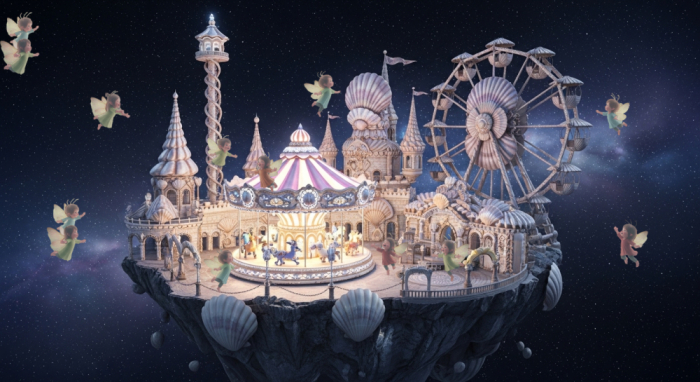

 Microshells Theater
Microshells Theater